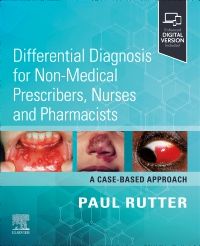As pharmacists and nurses are asked to take on greater responsibilities and extend the scope of their practice, this new book will support you to triage and manage patients using a clinical decision-making approach.
Unlike existing textbooks that cover symptoms management or provide a checklist format, Differential Diagnosis for Non-medical Prescribers, Nurses and Pharmacists: A Case-Based Approach provides case studies of common presentations with examples of associated clinical reasoning techniques to help you make a differential diagnosis.
The book covers a broad range of symptoms and is ideal for exam revision as well as for practising health professionals who wish to improve their experience and exposure to common patient situations.
Key Features
- Case studies contextualise knowledge into clinical cases
- Easily digestible information based on common symptoms seen in clinical practice
- Uses clinical reasoning techniques to provide examples of how to make a diagnosis
- Provides summaries of conditions that need to be considered in the diagnostic process
- Aligned to content in the fifth edition of Community Pharmacy; Symptoms, Diagnosis and Treatment
- An enhanced eBook version is included with purchase. The eBook allows you to access all the text, figures and references, with the ability to search, customise your content, make notes and highlights, and have content read aloud
Author Information
By Paul Rutter, PhD, SFHEA, Professor in Pharmacy Practice, School of Pharmacy and Biomedical Sciences, University of Portsmouth, Portsmouth, UK
1. Making a Diagnosis
The Use of Clinical Reasoning
Making a Diagnosis
2. Skills Needed to Facilitate Clinical Reasoning
3. Eyes, Ears, Nose and Throat
Case 1: Acute Red Eye
Case 2: Acute Red Eye
Case 3: Acute Red Eye
Case 4: Eye Irritation
Case 5: Eye Soreness
Case 6: Earache
Case 7: Dizziness
Case 8: Hearing Loss
Case 9: Upper Respiratory Tract
Case 10: Epistaxis
Case 11: Nasal Congestion
Case 12: Sore Throat
4. Gastrointestinal Problems
Case 13: Abdominal Pain In A Child
Case 14: Diarrhoea
Case 15: Lower Abdominal Pain
Case 16: Painful Oral Lesion
Case 17: Painless Oral Lesion
Case 18: Rectal Bleeding
Case 19: Upper Abdominal Pain
5. Skin
Case 20: Facial Rash in a Child
Case 21: Generalised Pruritus
Case 22: Hair Loss
Case 23: Itchy Rash on the Hand
Case 24: Maculopapular Rash
Case 25: Rash on the Arm
Case 26: Rash on the Chest
Case 27: Suspect Mole
Case 28: Torso Rash in a Child
6. Pain Problems
Case 29: Back Pain
Case 30: Facial Pain
Case 31: Foot Pain
Case 32: Frontal Headache
Case 33: Knee Pain
Case 34: Menstrual Pain
Case 35: Request for Sumatriptan
Case 36: Shoulder Pain
Case 37: Wrist Pain
7. Respiratory Problems
Case 38: Child With Croup-Like Symptoms
Case 39: Chronic Cough
Case 40: Cough In an Asthmatic Patient
Case 41: Upper Respiratory Tract Symptoms
8. Women’s Health Issues
Case 42: Abnormal Uterine Bleeding
Case 43: Suspected Urinary Tract Infection
Case 44: Vaginal Discharge
Case 45: Vaginal Itching
9. General Physical Problems
Case 46: Insomnia
Case 47: Leg Swelling
Case 48: Tired All the Time
Case 49: Unexplained (Unintentional) Weight Loss
Case 50: Voiding Problems
"...aims to provide case studies of common diseases to assist with differential diagnoses.... [Its] purpose is to showcase the most common primary care diseases through case presentations to facilitate clinical reasoning for non-medical prescribers, [which] are noteworthy objectives as many roles such as pharmacists and nurses have expanded, and the book allows additional support for their clinical decision-making.... [W]ritten for undergraduates and practitioners new to clinical reasoning, particularly for pharmacists and nurses with advanced degrees,... as it provides a learning tool to improve clinical abilities.... [It] is useful as it is intended to aid non-medical practitioners who perform a triage role in primary care settings. [Also] emphasizes the effectiveness of clinical reasoning when making a diagnosis as well as skills needed to facilitate clinical reasoning through communication, evidence-based practice, and shared decision making." ©Doody's Book Review Service, 2025, Yen Dang, PharmD (University of Maryland Eastern Shore)


